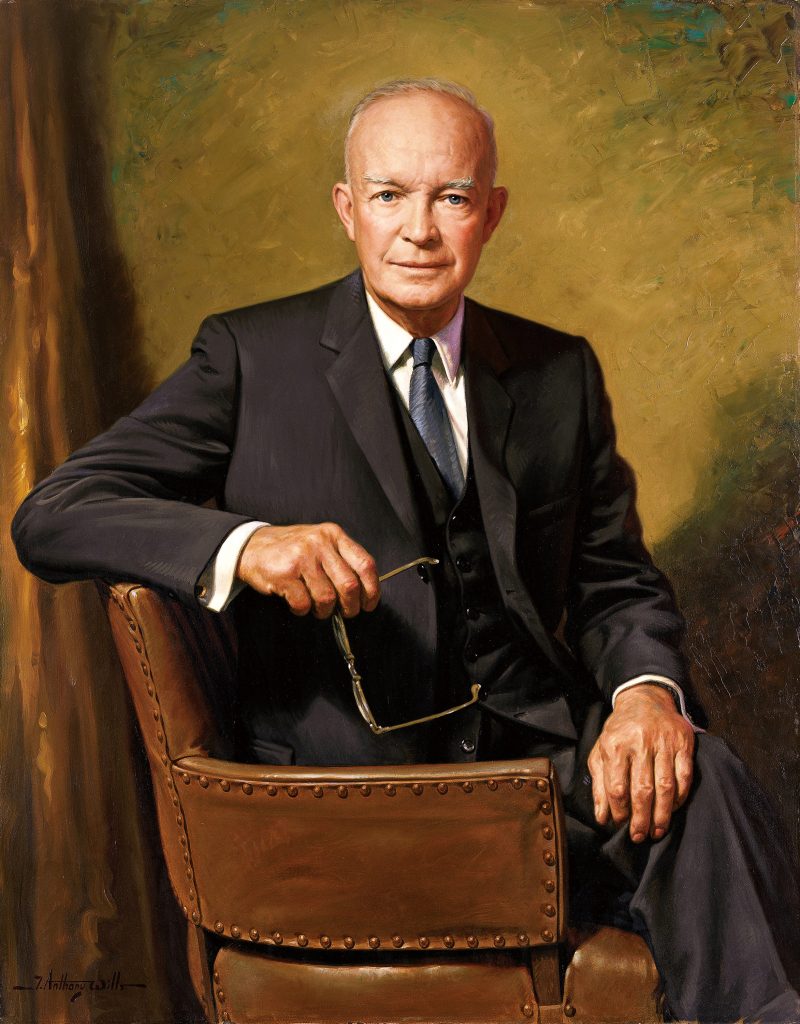Dwight D. Eisenhower Biography
34th President of the United States
Years Served as President: 1953-1961
Vice President: Richard M. Nixon
Party: Republican
Age at Inauguration: 62
Home State: Texas
Date of Birth: October 14, 1890
Died: March 28, 1969
Married: Mary “Mamie” Geneva Doud
Children: Doud, John
Nickname: Ike

What is Dwight D. Eisenhower known for?
Dwight D. Eisenhower is best known for his military career. He was the supreme commander of the Allied forces during World War II.
He planned the famous D-Day invasion of Nazi-occupied Europe. The invasion helped push the Nazis out of France and was one of the deciding victories of the war.
Early Life
Dwight D. Eisenhower was born in 1890 in Denison, Texas. However, he spent most of his childhood in Abilene, Kansas, a small farming community.
His parents were David and Ida Eisenhower. Dwight’s father worked as a mechanic. His mother was a Mennonite who was against war or violence of any kind.
Growing up, Dwight enjoyed fishing, hunting, and football. He also liked to read books about military history. In 1911, he was accepted to West Point.
After graduating, Eisenhower began his military career. He started as a second lieutenant in San Antonio, Texas.
Family Life
While in San Antonio, Eisenhower met and married Mary “Mamie” Geneva Doud.
The couple had two sons, Doud and John. Doud died of scarlet fever as a young boy. John graduated from West Point like his father, eventually serving in the military and becoming a military historian.

Military Career
Eisenhower was a talented leader who quickly rose through the military ranks. He soon became a brigadier general.
After leading several successful operations during World War II, Eisenhower became a five-star general.
He was named the supreme commander of the Allied forces and led the D-Day invasion of Normandy.
More than 150,000 Allied forces stormed Nazi-occupied France and liberated Paris from the Nazis. This turned the tide of the war decisively in favor of the Allies.
World War II ended not long after the successful invasion. Eisenhower returned home to a hero’s welcome. In 1945, he was appointed chief of staff of the U.S. Army.
In 1948, Eisenhower briefly returned to civilian life when he became the president of Columbia University in New York City.
But just two years later, President Harry Truman asked Eisenhower to command the North Atlantic Treaty Organization (NATO) troops in Europe.

Presidential Campaign
Soon, Republicans began encouraging Eisenhower to run for president. He was uncertain at first, but he finally agreed to run in 1952.
Eisenhower’s nickname was “Ike,” and he ran under the catchy campaign slogan, “I Like Ike.” His running mate was Richard Nixon, then a senator from California.
Since Eisenhower was so popular with the American people, he won the election easily. He defeated Adlai Stevenson, the governor of Illinois.
Presidency
As president, Eisenhower continued most of the New Deal and Fair Deal programs of Franklin Roosevelt and Harry Truman.

He also strengthened the Social Security program, raised the minimum wage, and created the Department of Health, Education, and Welfare.
Eisenhower also created the Interstate Highway System. This involved the construction of 41,000 miles of roads stretching across the United States. Alaska and Hawaii were admitted to the Union.
Other accomplishments during Eisenhower’s presidency included:
- Signing the Eisenhower Doctrine, which stated that any country could request help from the United States if it was being threatened by another country. This was designed to stop the spread of communism. He also authorized secret operations against communism by the CIA.
- Signing the Civil Rights Acts of 1957 and 1960. He created a civil rights office in the Department of Justice and supported the integration of schools.
- Helping negotiate an end to the Korean War.
After having a heart attack in 1955, Eisenhower’s health started to decline. Still, he won another landslide victory against Adlai Stevenson and served a second term.
His two terms were fairly prosperous and peaceful.
After the Presidency
After leaving office, Eisenhower retired with Mamie to his farm in Gettysburg, Pennsylvania. He raised cattle and painted.
He and his wife traveled and spent time with a close group of friends they called “the gang.”
Eisenhower occasionally consulted with current presidents and provided military advice. He worked on his memoirs and wrote several books during his retirement.
In 1965, Eisenhower suffered a second heart attack. His health grew much worse in 1968, and he spent nine months in the hospital before passing away on March 28, 1969 at the age of 78.
Fun Facts About Dwight D. Eisenhower
Eisenhower’s given name was David Dwight Eisenhower. However, he went by his middle name and eventually switched the two names permanently. His grandson was also named David.
Eisenhower and his wife moved 30 times during their first 35 years of marriage due to his military life. They never purchased a permanent home until after he became president.
At the Potsdam Conference in July 1945, Eisenhower spoke out against using the atomic bomb on Hiroshima and Nagasaki.
Eisenhower’s Interstate Highway System was the largest public works project in U.S. history.
In recent polls of the greatest U.S. presidents, historians have ranked him among the Top Ten.











